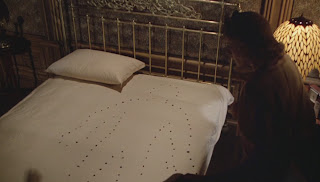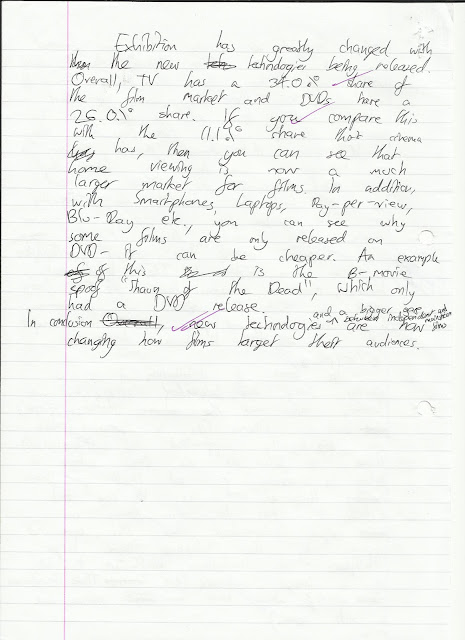The film "Casino Royale" (2006, directed by Martin Campbell) is a great thriller/action-adventure film. This film could be classed as a thriller, but there are some sequences where the film turns into an action-adventure film where the main character, James Bond, performs stunts that are unrealistic and manages to survive an onslaught of gunfire. However, the grittiness of the film, along with more realistic fights and settings, make it much more of a thriller than previous Bond movies. To show the two genres this film spans, I have chosen two scenes and analysed them.
Thriller: The opening black and white scene
This opening scene is a great example of a thriller scene. It starts with a car drawing up to a building - the area is lit by chiaroscuro light from the street lamp. this suggests that, like the lack of light, there is a lack of good and peace in this area. The black and white used in this opening sequence is used for multiple reasons - it shows that the sequence is in the past, it is a reference to older noir thrillers (e.g. Psycho), and creates a hostile atmosphere. There are many shadows used in this sequence - this implies that the area contains many dark secrets and mysteries. The room where the man is confronted by Bond is small and cramped - this is a generic thriller location. Also, the flashback to the toilet where Bond murders someone (the black and white also tells us that this is also a flashback) has many thriller conventions in it. The location, a small, claustrophobic, grimy toilet is a generic thriller location. This location has been used in many other thrillers, such as Witness (the murder sequence) and Psycho (the shower scene), providing intertextual links to other thrillers. Showers and toilets are used at other points in this film, such as when Bond fins Vesper upset and sitting in the shower. This strengthens the intertextual link. The gritty, desperate fight and murder tells us immediately that this is not a light-hearted family film - it is a thriller, with a new, physical, gritty James Bond character. This is reinforced by other scenes in the film, especially the torture scene.
Action/Adventure: The chase scene near the start of the film
This chase scene, where Bond chases a target through building sites and national embassies, is primarily an action/adventure sequence. The chase begins with a great bird's eye view shot to set the scene and inform us of everything that is happening immediately. The first major point that makes this an action/adventure sequence is when the mark fires a gun at Bond through the windshield of the digger James Bond is driving. All of the bullets miss Bond - while this is possible, as many bullets hit the windshield of the small compartment where Bond is, it is unlikely they would miss. In addition, the two characters perform quite extreme parkour when they are in the pursuit. On the other hand, this is not over the top - trained agents such as Bond would be able to perform some of the stunts performed. When the mark is climbing up the building site, he is also extremely accurate with a pistol (during the over the shoulder shot, which brings you more into the character's situation and his shooting), even though he barely looks down the sight and the targets are far away. This is highly unlikely, but for excitement purposes, it is manufactured. When Bond and the mark both reach the very top, panning and tracking shots are used to display the whole scene. It immediately tells you what is happening, and it makes the events at the top of the industrial site more epic and breathtaking. The hand on hand fight at the top is probably the best example of Hollywood action/adventure in the whole film. The characters always mange to hang on, defying gravity. It is likely that one would lose their footing as they are fighting in an extremely narrow place. Finally, when the characters make huge jumps and perform impressive stunts, they take little damage when they fall or hit the ground. There is little blood anywhere in the scene - the characters just get dirty. Realistically, the characters would take more damage - but for reasons such as keeping the characters looking good, they do not take much visible damage.
At the end of this scene, you are told an important thing about this incarnation of James Bond's character. He goes through all of this to get the mark alive, but when he is cornered right at the end, he kills the mark because he will not be able to capture him. This shows a large amount of recklessness, which is then highlighted again multiple times in the film.
Other noteworthy aspects of the film:
The main enemy of the film, Le Chiffre, carries an inhaler and has a problem that makes him "weep blood". This tells us many things about the character. His inhaler highlights a weakness - asthma. This can be taken advantage of - Bond bugs his inhaler when in the Casino Royale. "Weeping Blood" implies evil. Immediately, it makes us think of him as sinister, dangerous and evil.
 |
| James Bond bugging Le Chiffre's inhaler - a weak point of the character |
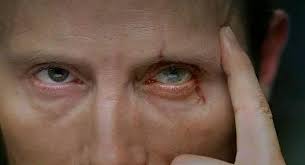 |
| Le Chiffre weeping blood |
A key scene in the film is the torture scene. After this scene, the film turns into a romance story, but this serves as the final chapter in Le Chiffre's role as the main enemy of the film. The chiaroscuro lighting in this scene makes the location more unsettling and uncomfortable. The location for this key scene is a generic thriller location - dark, damp, cramped, and claustrophobic. The whole scene is gritty and dark - possibly the darkest in Bond history. The close-up shots involve you more into the scene, making the torture more horrific. When Le Chiffre is killed,there is a low angle shot of his killer, with Le Chiffre pleading for his life outside of the shot. The low angle shot makes his killer seem more dominant and powerful.
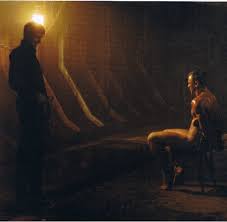 |
| Torture scene - chiaroscuro lighting on display |
The next scene is in a location that seems like paradise - this provides a huge contrast between the torture scene and the scene where Bond regains consciousness. This makes the two scenes seem like hell and heaven. The opening shot of Bond's eyes has intertextuality with other thrillers, such as the infamous shot of Marion Crane's eye in Psycho - this strengthens the film's link with thrillers and the thriller genre.
At the end of the film, a character with spectacles is seen. One glass of his spectacles is blacked out - this immediately tells you he is corrupted by darkness and evil - this tells you how to think of him straight away.
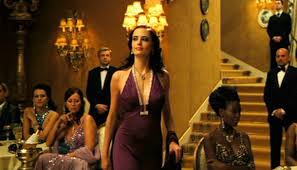 |
| Vesper using her sex appeal to distract the poker players |
The film is quite stereotypical is terms of gender. The female characters are often sex symbols - hence the term "Bond girls", while the men are powerful figures - Bond, Le Chiffre, etc. There are exceptions, however. "M" is a powerful female figure who is looked up to. She can even intimidate Bond, and make him back down. Also, the female figures are often strong characters, as well as being sex symbols. e.g. Vesper is a powerful, intelligent agent. She is a great example of a femme fatale - she uses her attraction to manipulate
people e.g. when she is used in the Casino Royale to distract the players with her beauty. She also tricks everyone at the end by betraying Bond just as you think they are going to set out on a happy life together. This could be a negative female representation, however - she is untrustworthy. Also, her tricks catch up with her, as she dies at the end of the film. The femme fatale is a thriller convention - this again reinforces the film's link to the thriller genre, rather than the action/adventure genre.
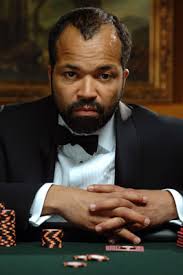 |
| Felix - a good representation of black people |
Furthermore, most of the black characters in this film are enemies, criminals or bad men. This is a very negative representation of black people. The one exception is Felix - a trustworthy, good-natured character who is a good ally to James Bond in the film. He is a positive representation of black people.

